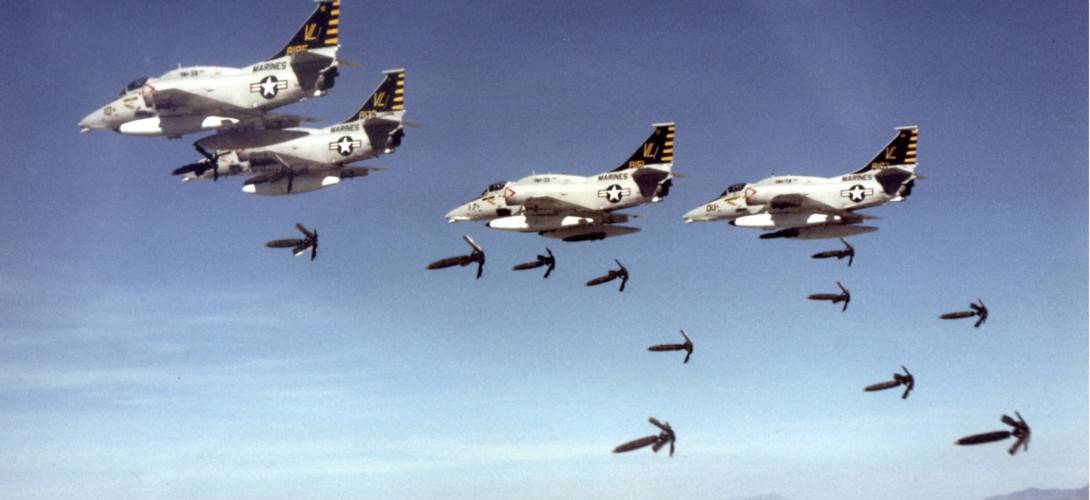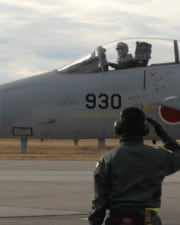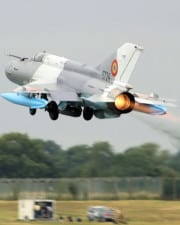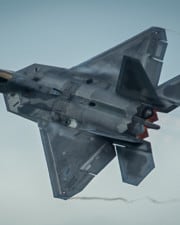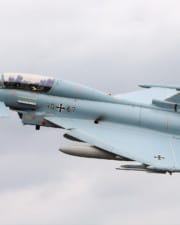Bomber planes became an essential military asset during the First World War and Second World War. Dropping bombs from planes allowed militaries to hit large-scale targets, including industrial facilities and infrastructure thus crippling the enemy. From strategic to tactical bombers, there are many different types of bomber planes.
Table of Contents
The first use of an aircraft as a bomber occurred on October 16, 1912 during the Italo-Turkish War in Libya. An Italian pilot dropped a bomb from an Albatros F.2 aircraft.
A year later, the Italians developed an aircraft purposely for bombing. The original bombers were modified single-engine biplanes with bomb carriers in the lower forward fuselage. Each plane could carry 12 10-pound bombs.
Bomber planes evolved rapidly during World War I. At the start of the war, a pilot would throw hand-held bombs from the side of the plane. By the end of the war, British and French forces had developed more advanced bombers, including long-range bombers with computer-aided bomb-dropping mechanisms.
During World War II, armed forces relied more heavily on bomber planes. Due to the cost and time needed to manufacture aircraft, militaries began designing bombers that were tailored to specific roles. This led to the creation of dive bombers, torpedo bombers, and many other types of bomber planes.
1. Strategic Bombers

A strategic bomber is one of the two main classifications for bomber planes. A strategic bomber is an aircraft equipped with bombs and intended to take out strategic targets, such as supply vehicles, bases, factories, bridges, and even cities. Militaries use strategic bombers to limit the enemy’s wartime production capabilities.
Most strategic bombers are heavy aircraft designed to carry large payloads. The first examples of strategic bombers were multi-engine biplanes used for long-range bombing raids. The Germans and the British used bombers to target areas across enemy lines.
One of the most well-known strategic bombers is the B-52 Stratofortress. The B-52 can carry up to 70,000 pounds and has a combat range of over 8,800 miles. The Northrop B-2 Spirit (Stealth Bomber) is also currently in service. It can carry 80 500-pound GPS-guided bombs or 16 2,400-pound nuclear bombs.
2. Tactical Bombers
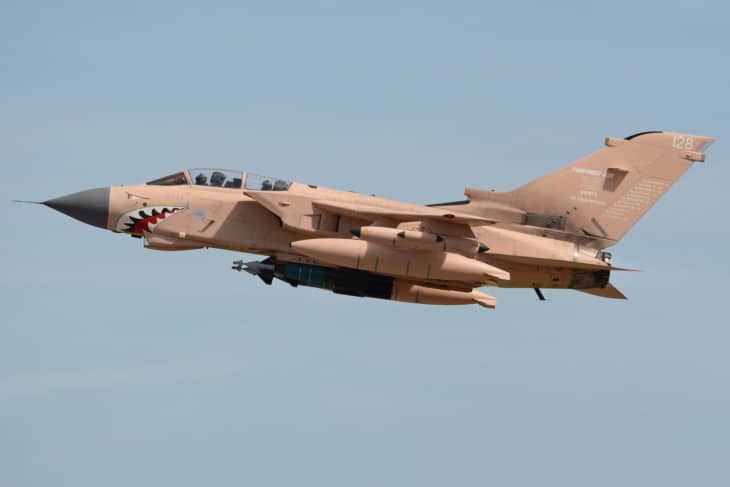
Tactical bombers are aircraft designed for tactical purposes, such as counter-offensives and providing air support for ground units. Compared to strategic bombers, tactical bombers operate at shorter ranges, often near the ground. There are many subcategories of tactical bombers, including light, medium, dive, and attack bombers.
Tactical bombers may carry 2,000 to 4,000 pounds of weapons, which is a much lighter payload compared to heavy bombers. They may also be equipped with defensive armaments for targeting other aircraft.
Many modern tactical bombers are multi-use aircraft, such as the Panavia Tornado IDS, the Mirage 2000D, and the Xian JH-7. The Tornado IDS has been used in several wars throughout the 1990s, typically for low-altitude strike missions.
3. Light Bombers

Light bombers are a type of tactical bomber designed to drop bombs over targets. They were primarily used during World War I and World War II. However, by the end of World War II, advancements in aeronautical design made purpose-built light bombers obsolete.
Light bombers replaced the old biplanes that acted as the original bombers for air forces during World War I. The new light bombers were single-engine or twin-engine aircraft and could carry up to one ton of weapons. During World War II, light bombers became faster and suitable for a wider range of operations.
The early dive bombers and torpedo bombers were light bombers that had been modified to suit new roles. For example, the Junkers Ju-87 and the Vultee Vengeance were both classified as light bombers but mostly flew dive-bombing missions.
4. Medium Bombers

Medium bombers are another type of plane used for tactical bombing. They are designed to deliver medium-sized payloads over medium-range distances, which separates them from the smaller light bombers and the larger heavy bombers.
As with torpedo bombers and light bombers, a medium bomber is a classification that is no longer used. The term was phased out as fighter aircraft became faster and capable of carrying larger payloads. Modern medium-range tactical attack aircraft, such as the F-111, fill the roles left by medium bombers.
One of the few examples of a purpose-built medium bomber is the B-47. The US Strategic Air Command used the “medium bomber” classification to separate the B-47 from the larger B-52 Stratofortress. The B-47 could carry up to 20,000 pounds of weapons while the B-52 could hold up to 70,000 pounds.
5. Heavy Bombers

Heavy bombers are typically used for strategic bombing missions. They are too large and lack the defensive capabilities for close combat with other aircraft or ground units. Heavy bombers fly long distances to drop bombs over targets from high altitudes. They are also the largest and most powerful military aircraft.
Heavy bombers were used to drop atomic bombs over Hiroshima and Nagasaki during World War II. The United States Air Force used B-29s to drop the bombs.
Before the B-29, the United States used the B-17 Flying Fortress. With a range of 2,000 miles and a maximum payload of 4,000 pounds, the B-17 was not suitable for war in the Pacific. The B-29 could carry over 20,000 pounds and travel up to 3,250 miles.
6. Dive Bombers

Dive bombers are tactical aircraft designed for vertical diving attacks. Based on the size, many dive bombers can also be classified as light bombers. They typically only carried several thousand pounds of bombs. Instead of dropping bombs over a target, dive bombers dive directly at targets for increased accuracy.
The most well-known examples of dive bombers include the Junkers Ju-87 and the Aichi D3A. The Junkers Ju 87 was operated by the Germans during World War II. It could dive at a steep angle, up to 80-degrees, minimizing horizontal velocity, allowing the bomb to drop at almost a straight line.
The increase of anti-aircraft artillery and precision-guided missiles led to the end of dive bombers after World War II. Instead of dive-bombing, militaries began to rely on guided missiles that could precisely hit targets.
7. Fighter-Bombers
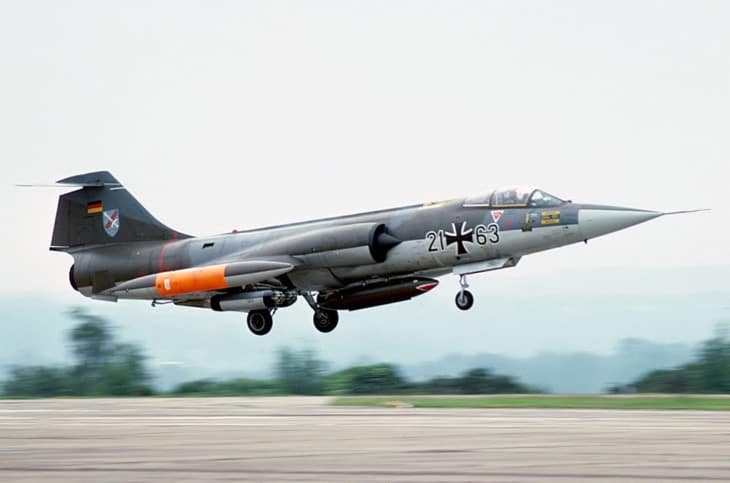
A fighter-bomber is a modified fighter plane that is used for tactical bombing operations. The original purpose-built fighter bomber was the Sopwith Salamander. The British Royal Flying Corps originally called the aircraft a “trench fighter,” as it was primarily used to bomb enemy trenches.
When World War II started, the original fighter bombers were too vulnerable to ground fire and attack from single-engine fighter planes. The new fighter bombers were versatile aircraft that were capable of bombing runs and engaging ground targets or enemy aircraft.
Fighter bombers became increasingly important during the Korean War. The Lockheed F-104 Starfighter is a common example. It offered increased speed and low-altitude performance and was often equipped with missiles, rockets, and guns. Over the years, fighter bombers eventually evolved into the interceptor and attack aircraft used by modern militaries.
8. Ground-Attack Bomber

A ground-attack bomber, or attack bomber, is a tactical aircraft designed to engage enemies at low-levels. An attack bomber may clear targets on a battlefield, such as tanks or large concentrations of troops. Attack bombers are typically equipped with machine guns, cannons, or rockets.
Most attack bombers can be classified as light bombers due to their smaller size compared to medium bombers or heavy bombers. Attack bombers may also be used as dive bombers or fighter bombers.
Modern ground-attack bombers use the prefix “A” in the US military. Examples include the A-6 Intruder and the A-10 Thunderbolt II. The A-6 was an attack bomber developed in the late 1950s and one of the first carrier-based attack aircraft for the US Navy.
9. Torpedo Bomber

A torpedo bomber is a historical type of bomber that is no longer in service. They were introduced by the British forces during the First World War. The original torpedo bombers were biplanes with floats for landing on the water and fitted with a torpedo and a quick-release mechanism.
The first torpedo bomber took out two supply ships in the Gallipoli campaign in 1915. The designs were eventually refined, which led to the development of the Bristol Beaufort. The Bristol Beaufort was a twin-engine bomber with a bomb-bay that housed a semi-recessed torpedo.
By the Second World War, most battleships could easily evade the torpedoes dropped by torpedo bombers. The torpedo bombers were eventually replaced by anti-ship missiles and more sophisticated aircraft. The existing torpedo bombers were often adapted to become multi-role aircraft, such as light bombers/attack aircraft.
10. Patrol Bomber

The patrol bomber is another type of bomber plane that has become obsolete. The original patrol bombers were used by the Air Force and Navy to scout the waters and airspace and take out ships and submarines.
During the Second World War, the Navy used twin-engine flying boats as patrol bombers. There are many converted and purpose built aircraft for the role, such as the British Bristol Beaufort and American Consolidated PB4Y-2 Privateer. However, they did not offer the range needed for long-distance patrolling. They also lacked the loitering speeds needed to target submarines.
After World War II, the use of patrol bombers was slowly replaced by modified civilian airliners. Airliners offered greater speed and were often equipped with advanced surveillance systems, such as radar detecting equipment. They are now more commonly known as maritime patrol aircraft.
Related Posts
